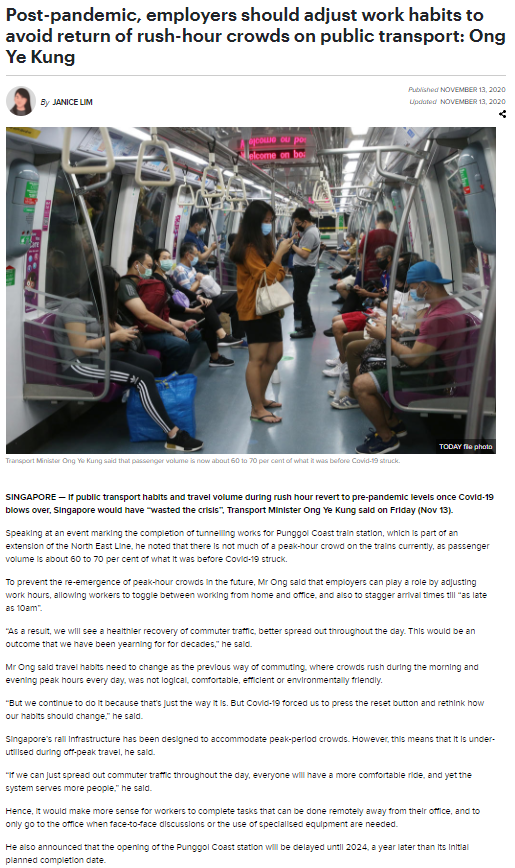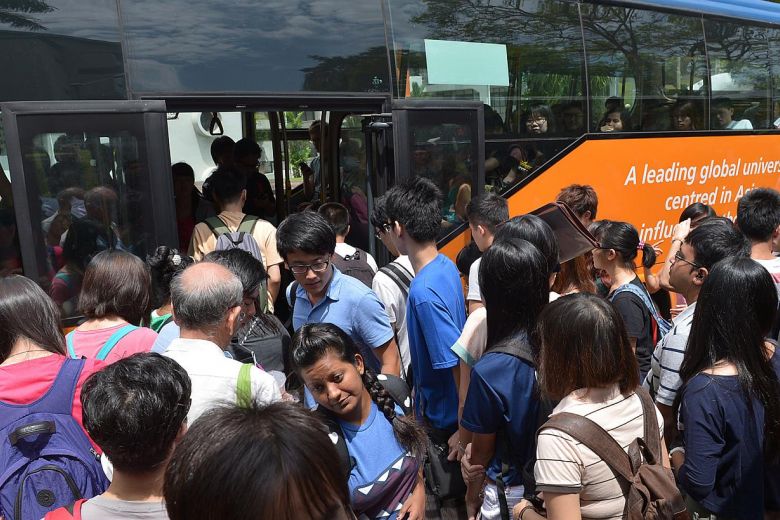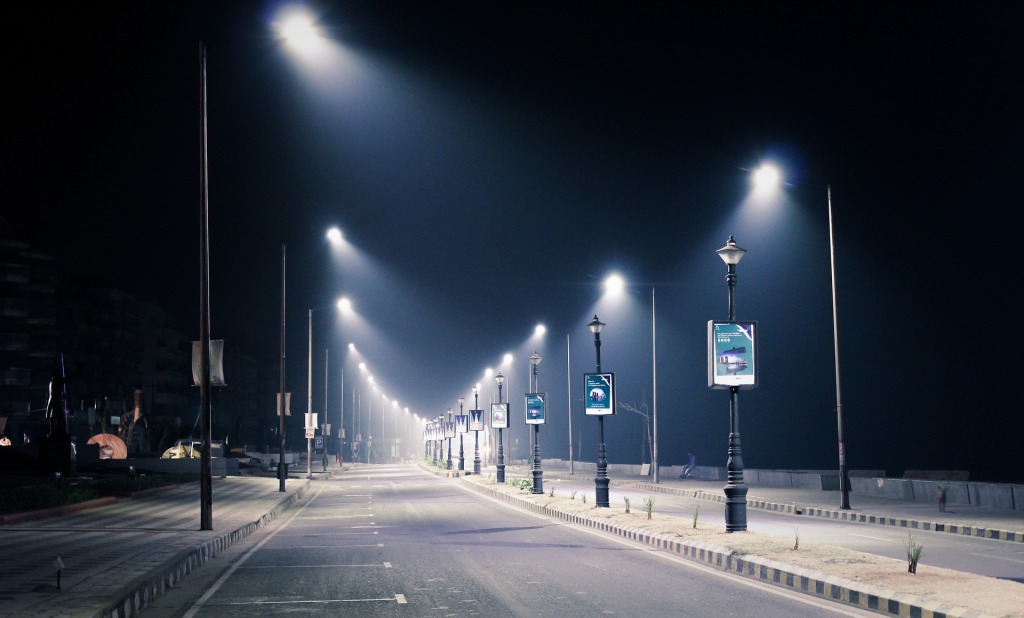I was working on my next article when I saw a comment from the Minister of Transport, Mr. Ong Ye Kung, remarking on how “employers should adjust work habits to avoid return of rush-hour crowds on public transport”.

I paused, raised my eyebrow a bit, and then read the next sentence: If public transport habits and travel volume during rush hour revert to pre-pandemic levels once Covid-19 blows over, Singapore would have “wasted the crisis”.
And I thought to myself: Wow, such strong words. Maybe I should write say something about it and publish that one instead in short order.
In fact, this was the research topic of my Honours thesis when I was an undergraduate studying Economics, so I am in a good position to comment. And what I can say is that the government actually has “tried” for a long time now to reduce peak-hour loads on the transport system through a variety of ways.
So why we are still talking about the same problem year after year? Indeed one can sense a hint of frustration from Mr. Ong, suggesting that more can (needs) to be done.
What has this got to do with Economics?
I get that a lot.
I realised that not many realise that the subject is more than about money. In fact, Economics is a social science that studies human behaviour in the context of resource allocation and (not necessarily monetary) transactions.
As an example, my thesis’ focus fell under the category of Behavioural Economics, which is more traditionally associated with Psychology. In fact, the social sciences, including Economics, Sociology, Psychology, Geography, to name a few, tend to overlap significantly and it is not uncommon for these disciplines to collaborate and share inspirations.

The motivation – a.k.a got problem meh?
I could wax lyrical about how I was doing <something>, and it suddenly dawned on me one day that there existed a possible < solution>, and how that inspired me to write a smashing <thesis>.
Fat hope.
I committed myself to a whim of mine (there was no requirement for me to write a thesis for graduation) and I had to accept the consequences. So I had to find a research focus and it preferably had to be one where I could do an empirical study on.
It also happened that travelling to NUS during peak hours was a total pain. To keep the story short, that unhappy confluence of events plus a few matters that came along led me to my eventual research topic.

Usually, an empirical study is motivated by some problem. This was no different. Very “peak-ish” travel demand is problematic for a few reasons:
- Congestions suck for the commuter;
- Congestions suck for the transport operators and affiliates; and
- The requirement to reduce the suckiness above demands inefficient resource allocation solutions that involve “catering just right” during peak hour, and having idle resources during off-peak hours.
The somewhat obvious solution to killing all of these birds with one stone simultaneously is to spread the travel demand across a larger time-span each day – except that it is easier said than done.
Why so hard to solve?
At the heart of it, is the institutional factor.
As my thesis supervisor, the late A/P Anthony Chin pointed out with some “folksy” wisdom as early as 1990 (those were the days of ALS and not ERP!), people do not simply travel early to work (late was obviously not an option) to enjoy yet-to-open facilities. Those were the days before 24 hour gyms were the rage and “early” meant before 8am.

In addition, standardised working hours help to ensure consistency in work interactions across the nation. So it’s not hard to see why shifting towards “more flexible” start-times is not so straightforward.
Things might have changed somewhat today with more leeway to working hours being increasingly common. But evidently not to the extent that would help the transport system more substantially.
So if shifting work-hours will not happen overnight, why not consider carrots and sticks? The latter is not politically correct and we haven’t become so “desperate” yet to seriously consider it. That leaves “carrots” as the next viable target for improving congestion.
It was 2012/13 and INSINC was in.
The carrot dangled at that time by LTA/Transitlink was the INSINC trial program, which rewarded participants who travelled outside the core peak hour.
Similar to present-day Travel Smart Journeys program, which was actually a descendent of the original INSINC program, participants accumulated points based on their avoidance of the core peak period, which they could use to play a snakes-and-ladder game (I kid you not), and win rewards as below.

The most obvious question back then was: What is the rewards-elasticity of peak-hour commuters towards switching out of peak hour travel? In more normal-speak: How much money will we need to throw at you to get you out of peak-hour travel?
Surely that would have been my research focus? Alas, I admit unabashedly that it was not the case due to sheer complexity (and it was “boring”). Instead some frenzied research on my part revealed that Singapore would not have been the first to try, and many similar studies focused instead on the behavioural aspect to it.
So that basically decided my research focus, which was to un-originally follow such similar studies: Does Past Behaviour Predict Future Behaviour? A Discrete Choice Analysis on Travel Behaviour.
To be fair to myself, I should point out that:
- INSINC was a novel scheme at that time in Singapore, and social scientists have a fetish for before-after phenomena studies on behaviour (read tremendous opportunity for me);
- Behavioural studies were incredibly sexy then (and now); and
- I had access to actual travel data courtesy of LTA (I actually took a sabbatical from my studies to work for them in return).
So after all was done and dusted, what did I find out?
Past travel behaviour does predict future travel behaviour.
Without boring you to death with my research methodology (you can leave comments below if you would like to know more), it was empirically shown that commuters did respond to the incentives, albeit to a small extent only and with time.

So no surprises there. But what could be some possible reasons?
We mentioned institutional factors earlier. But some other possibilities include:
- The “psycho-ing” part was not enough (behavioural changes can actually be made based on subjective rather than objective incentivisation);
- Planned behaviour relating to travel time being repeated often enough such that certain bias form in conscious choice-making (not the same as “habit”);
- Habitualisation of routine (i.e. old habits die hard);
- Self-identity and/or personal moral beliefs (older folks like myself may have internalised such lesson that early birds get to eat the worm – a common Chinese saying).
I am happy to state that nailing down which of these causes were the culprits was beyond the scope of my research (read the title of my thesis!). These are tough questions and many researchers dedicate their lives to pursuing such knowledge. Today, we owe much of our understanding to them.
My key contribution was to confirm the hypotheses in these theories predicting that behavioural changes faced many impediments. It was hard work enough, especially having to defend my research methodologies against the onslaught of grading professors!
So was Mr. Ong right to look at employers?
Yes – and no question about it.
Having said that. institutional factors (I am looking at the government now) are the most important factors, and they affect all the postulations I had cited earlier.
Having employers implement staggered work hours and reducing need to travel would definitely go a very long way to solving the perennial peak-hour congestion, but that would more likely happen when the Public Service walked the talk more.
If that has already happened, then the messaging to the private sector must be made more obvious, because the general impression is that flexible working hours isn’t quite the default situation in the Public Service.
This is all the more the case when I had empirically proven previously, that dangling carrots have had very limited effects on changing travel behaviour in isolation. Mr. Ong was therefore right to point out that we need to do more.

